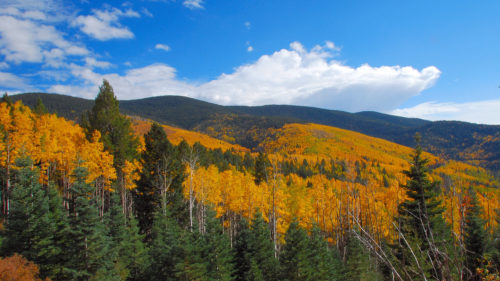(This story first appeared in the Fall 2015 Outdoor Reporter)
Most New Mexico hunters focus on elk, deer and other big game species, but big predators are what seem to catch the general public’s attention. When the Bear and Cougar Rule comes up for renewal every four years, the public outcry typically overwhelms anything that licensed hunters have to say.
This year was no different, although the outcry was even louder than usual. Bear and cougar advocates were joined by Mexican wolf supporters after the Department of Game and Fish denied permits to import, hold and transplant wolves in southwest New Mexico – despite the state law that requires the Department to restore the wolf population to the point where it is no longer an endangered species.
New Mexico residents buy about 2,700 bear tags a year and 1,700 cougar tags, which puts both species at the low end of hunter interest. In contrast, the Department of Game and Fish sells nearly 27,000 deer tags to residents alone, and almost 22,000 elk tags.
But the State Game Commission meetings were packed this year every time the Bear and Cougar Rule came up – not with hunters but with people holding up protest signs.
New Mexico Wildlife Federation supported the bear proposal when it was unveiled in June, but opposed the cougar rule changes. Both stances revolved around upholding the highest standard of thorough, science-based wildlife management. The Department justified its proposed increase in bear harvest with two new studies. For cougar, however, no legitimate scientific justification was given for why the Department wanted to allow more cougar trapping under the guise of “sport hunting.”
In response to a long list of questions from NMWF about bear and cougar management, Game and Fish Wildlife Management Division Chief Stewart Liley explained some of the science that drives the management of two of New Mexico’s most controversial predators.
Generally, Liley said, Game and Fish wants a balance between top-down predation and prey species. Predators of all sizes are an integral part of the ecosystem, helping keep prey populations both healthy steady and reducing the “crash and boom” cycle that can occur when predation is missing.
But managers also need to include humans in the mix, he said. Humans are another apex predator, and hunting is a tool for balancing predator/prey numbers. But humans also affect wildlife in other ways, through road construction and habitat fragmentation, grazing, forest management practices and the like. Public opinion is yet another factor, as predator management can be extremely controversial – on both sides of the equation.
Amidst all the competing pressures, Liley said, “Wildlife managers must use scientific data to determine acceptable predator densities within varying regional, ecological, prey densities and sociological contexts.”
The Department relies both on its own studies and research done elsewhere as the basis of its wildlife management, including predators. But as with most species, the science suggests that there are no pat answers or rules of thumb to guide decisions, like the idea that “predators cull the old and weak.”
Hard-running wolves, for example, do take old and weak animals that can’t run as far or fast as others. Cougars, on the other hand, stalk their prey and will take whatever they can knock down and kill. Bears and coyotes target newborn calves, unless Mama drives them off with her hoofs.
Game and Fish reviews all its big game hunting regulations every four years, or when necessary to adjust to unforeseen circumstances. Bear and cougar are no different. The rules came up in 2011 and were controversial then, and they remained controversial when they came up again in 2015.
Department staff announced at the outset this year that the bear proposal was based largely on new data, including DNA studies conducted over the last three years. Based on DNA research involving “hair snares” in the Sangre de Cristo, Sandia and Sacramento Mountains, Game and Fish said there are more bears than previously thought in New Mexico, and called for higher harvests to match the wider distribution of bears. The proposal called for a statewide increase averaging about 20 percent.
Game and Fish now estimates the state’s bear population at nearly 8,000 and rising. Some of the increase is likely due to the better assessment methods, Liley said – the bears may have been there all along but were not accurately counted. But game wardens, hunters and landowners are also reporting more bear sightings. And a survey of harvest statistics, such as comparison between the actual harvest and the reported number of days spent hunting, as well as the age and sex of harvested bears and other data suggest an increasing population, he said.
New Mexico Wildlife Federation supported the proposal, largely because it was based on science, said NMWF President John Crenshaw. “The Department had thorough and compelling data to justify its proposal, which was bound to be controversial,” he said. “Good data is critically important so that hunters and the general public have confidence that management is based on science, not politics.”
Others were not so impressed, however. Bear advocates argued that the Department’s study results were not peer-reviewed, which is the gold standard for all scientific study. Specifically, groups like Sandia Bear Watch took issue with the statistical methodology, alleging that Game and Fish had based the harvest proposal on the high end of the bear density numbers rather than a more conservative middle, and with the mapping used to determine bear habitat.
(Bear numbers can also be significantly impacted by the annual production of mast crops such as acorns, pinon, juniper berries, choke cherries and even prickly pear fruit. Mast production is extremely varied on an annual basis and even from one watershed to another.)
When the Bear Rule came up for a vote, bear advocates essentially told the Commission that Game and Fish might be overestimating the number of bears in New Mexico, and therefore raising the harvest levels was not justified.
The Commission didn’t buy it, however, and approved the new proposal unanimously.
Liley later defended the science, saying the Department did use conservative bear density estimates and that the work was in fact reviewed by researchers all over the country. “It’s been peer-reviewed; it’s just not published yet,” he said.
Not many hunters target black bears, but they do have a stake in black bear management. According to Liley, research in the Valle Vidal, Valles Caldera National Preserve and Gila National Forest in recent years all showed that black bear predation was one of the primary causes of newborn elk calf mortality, though not on adult elk.
Based on that research, the Game Commission approved an experimental spring bear hunt in Valle Vidal in 2011 and 2012. By removing bears before the calving season, elk calf survival rates rose substantially (from 33 percent in prior years to 44-47 percent after the spring bear hunts). In response to the higher elk calf survival those years, additional mature bull licenses were offered in the Valle Vidal.
Some hunters want more spring bear hunting, but spring hunts were not part of the Game and Fish proposal this time around. Liley said the Department has recommended spring bear hunts only when research indicates bear predation is limiting ungulate populations.
While research drove the higher harvest limits for bear, this year’s Cougar Rule seemed driven by politics.
Sport hunting has not been a particularly effective way to control cougars in New Mexico, Game and Fish staff noted when the rule was introduced last spring. Although the statewide harvest total has been set at nearly 750 for several years, hunters rarely take more than 250.
That’s never sent shock waves through the hunting community, but members of the state Legislature have noticed. Rep. Zachary Cook of Ruidoso introduced a bill this year to reclassify cougars as varmints – and thus eliminate all seasons and bag limits. Although the bill died in committee, it sent a strong message that the agriculture industry believes there are too many cougars in New Mexico and that Game and Fish hasn’t done enough to control them.
(Game and Fish statistics on cougar mortalities don’t support allegations of a spike in cougar predation on livestock. Over the past 10 years, the number of cougars killed for livestock depredation has ranged from as few as four to a maximum of 26, but consistently hovered around the low 20s annually with no notable increase in the past few years.)
The Department’s initial cougar proposal looked like a direct response to the Legislature’s message. Although it didn’t raise the statewide harvest limit, it called for a monumental change in cougar hunting regulations in hopes of taking more cats every year – by allowing traps and foot snares as a legal sport hunting method anywhere in the state. NMWF and others denounced the idea of using traps as a sport harvest method, and the Game Commission didn’t support it either. NMWF’s position is that trapping indiscriminately takes females and kits, which is a monumental departure from the gold standard of game management.
But in response to questions and concerns raised by several commissioners, the Department came back with a second proposal that makes it easier for landowners to trap cougars on private land only – as Game Commissioners had requested. State Land Commissioner Aubrey Dunn also asked that trapping be allowed on State Trust Lands.
In reality, it’s a minor change. Game and Fish in the past provided free permits to ranchers to take cougars on their land, provided the trapper had a valid sport license. The new rule eliminated the permits and allows trapping on private and State Trust Land during the regular trapping season – November to March. The kill would be treated as sport harvest, but the trapper needs both a sport and trapping license.
NMWF opposed the idea of eliminating the permits because no research was presented to the public that showed cougar predation was a problem on either livestock or game animals.
“We have strongly supported targeted cougar trapping in the past when it was scientifically justified, such as to help desert bighorns,” NMWF’s Crenshaw said. “Without such justification now, we simply can’t support this proposal.”
Again, the Commission approved the proposal unanimously.
Today the Department estimates the statewide cougar population between 3,100 and 4,300, based on a habitat model developed in 2010. The model uses harvest reports and GPS radio collar information from 2001-09 along with a land cover classification system that describes habitat type at each location. Biologists applied information from cougar density studies in New Mexico and other states to come up with a population estimate.
Cougars were considered a varmint until 1971, when they were reclassified as a game species. Since then their numbers have risen, Liley said. Game and Fish opposed this year’s bill to reclassify mountains lions as varmints, even as former Department Director Jim Lane spoke in favor of the bill on behalf of Rep. Cook.
Although no new predation data was provided during the Cougar Rule discussion, that’s about to change. Liley said the Department and New Mexico State University are starting a $1 million cougar research program this winter that will better define cougar densities throughout the state. The research aims to collect genetic samples from individual animals and will use trail cameras to pinpoint their locations. Like the bear research, the habitat model for cougars will be revised using newer habitat cover classifications. The net result should be a more accurate picture of cougars in New Mexico.
Past research has shown that the main factor driving cougar populations is prey availability, Liley said. Although cougars prefer to prey on deer and elk, they can eat almost any animal. Even if the preferred prey is in decline – mule deer, for example – mountain lions can easily switch. One recent study found a cougar catching carp.
The Department is currently conducting a radio-collar study, again with NMSU, on cougar/deer interactions in the Gallinas Mountains near Corona. More than 50 deer have been collared to examine the influence of predation versus nutrition on deer mortality rates. The work will shed light on cougar predation rates and kill composition, which hunters will appreciate.
“Advances in GPS collar technology have allowed wildlife biologists to learn more details about cougar diets than was previously known,” Liley said. “Although they still prefer deer, elk and desert bighorn, they can eat large numbers of smaller animals and still survive.”
Game and Fish has been actively transplanting mule deer from areas where are too many – such as Silver City – to areas they are scarce, including the Caballo Mountains, Peloncillo Mountains and San Francisco River. Targeted cougar control is sometimes part of the program, Liley said, and information gleaned from the transplants will be another source of information about lion effects on deer populations.
“To give transplanted deer the highest probability of survival, potential release areas were evaluated for several factors including habitat quality, water availability and predation risk,” he said. Some of the transplants went to areas where cougar removal had been done earlier for desert bighorn sheep. Other areas had no cougar control at all.
Research to date in the Peloncillo and San Francisco River deer releases has shown that cougar predation accounted for 70 percent of all known-cause mortality and was the leading cause of mortality in all herds in all years. Complete results, including an analysis of impacts of cougar removal on deer mortality, should be available next year.
Liley said that contrary to concerns raised by NMWF and others in the past year, “We are putting more science into our recommendations (to the Game Commission) now. One example is that 10 years ago we probably had 50 radio-collars on all species around the state. Today we have over 300. We have more projects going with schools like Texas Tech and New Mexico State to gain a better understanding of wildlife populations and are using results from the research to guide our management decisions,” he said.
More broadly, the Department is doing research to determine how the whole wildlife ecosystem works, including the human factors, he said. “We’re trying to figure out what are the limiting factors in these populations of interest, like deer, elk and bighorn sheep, and trying to tease out the factors that impact them. So that eventually we can either improve upon or lessen certain impacts and provide greater opportunity for sportsmen.”
There will always be predators on the landscape, Liley said, “And we want them out there. But we want it in balance, to where we can allow some predation but not so much that a population declines to where we have to significantly limit hunting opportunity. The public wants science-based management and we’re getting there.”



